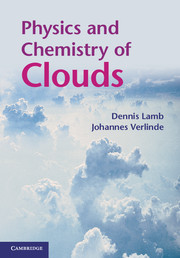Book contents
- Frontmatter
- Contents
- Preface
- Part I Background
- Part II Transformations
- Part III Cloud macrophysics
- Part IV Cloud microphysics
- Part V Cloud-scale and population effects
- 10 Evolution of supersaturation
- 11 Warm clouds
- 12 Cold clouds
- 13 Cloud chemistry
- 14 Cloud electrification
- Appendix A Cloud classification
- Appendix B Overview of thermodynamics
- Appendix C Boltzmann distribution
- References
- Index
11 - Warm clouds
from Part V - Cloud-scale and population effects
Published online by Cambridge University Press: 07 October 2011
- Frontmatter
- Contents
- Preface
- Part I Background
- Part II Transformations
- Part III Cloud macrophysics
- Part IV Cloud microphysics
- Part V Cloud-scale and population effects
- 10 Evolution of supersaturation
- 11 Warm clouds
- 12 Cold clouds
- 13 Cloud chemistry
- 14 Cloud electrification
- Appendix A Cloud classification
- Appendix B Overview of thermodynamics
- Appendix C Boltzmann distribution
- References
- Index
Summary
Overview
Warm clouds typically form in the lower troposphere when ice is not important to the microphysics. The development of warm clouds depends on condensation to activate aerosol particles and grow liquid droplets initially. Subsequent processes include drop–drop collisions, coalescence, and disruption during the formation of rain in mature clouds. Such processes may also occur in colder, mixed-phase clouds as long as the presence of ice does not interfere significantly with any of the warm-cloud microphysical processes.
The focus of this chapter is the spectral evolution of drop populations, how small (~ 10 μm radius) cloud droplets grow to large (~ 1 mm radius) raindrops. Many of the individual processes responsible for particle formation and growth have already been treated, so we now look at how these processes work collectively to form rain.
A perspective of how liquid-phase microphysics leads to rain in a warm cloud can be obtained by viewing the different processes as discrete boxes operating simultaneously inside the cloud. As shown in Fig. 11.1, one process leads to another, from initial activation of the aerosol entering the cloud in its updraft to rain falling out through its base. Overall, rain formation requires several broad categories of spectral evolution: condensation, coalescence initiation, and continuous collection. As supersaturation develops by adiabatic cooling of the rising air, the aerosol particles grow first as haze droplets, then as cloud droplets by condensation.
- Type
- Chapter
- Information
- Physics and Chemistry of Clouds , pp. 433 - 456Publisher: Cambridge University PressPrint publication year: 2011
- 1
- Cited by



